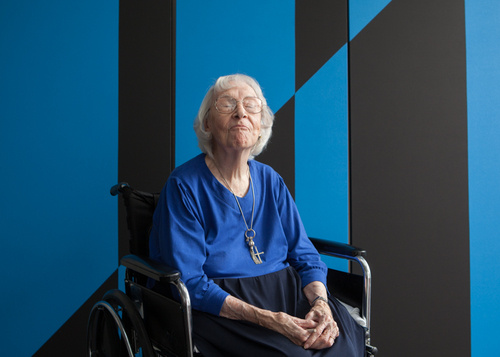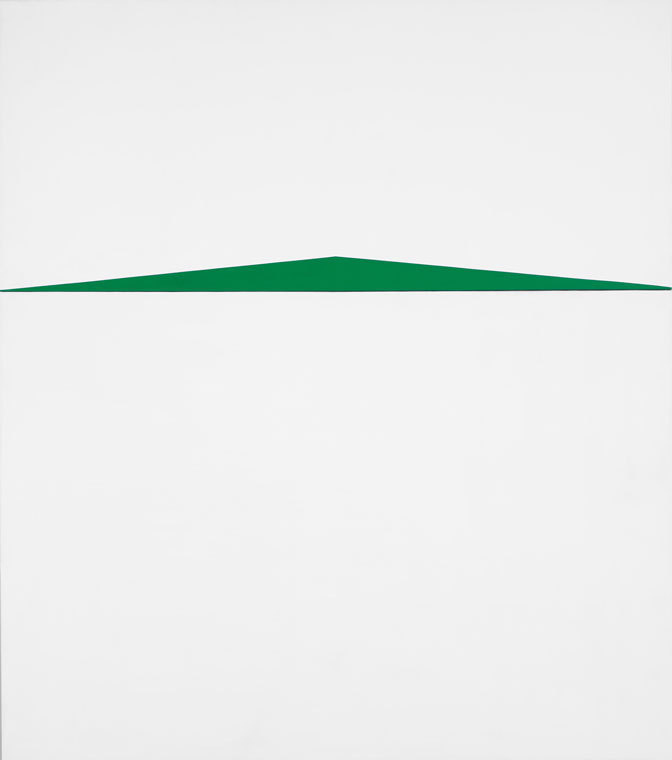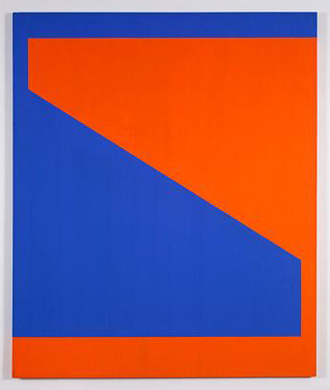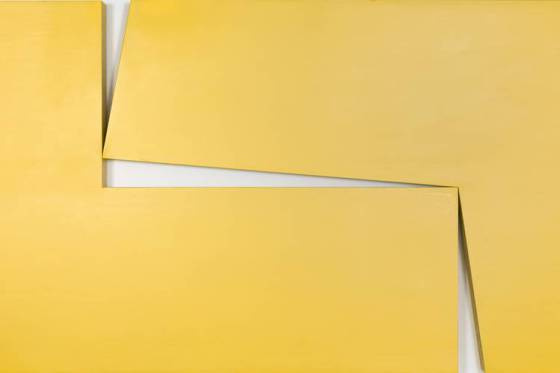Carmen Herrera, a 101-year-old Cuban-American abstract painter, finally found her recognition in the art world at the age of one hundred.

Her remarkable life-story is about a strong personality that stays true to her own vision in arts and never gives up despite prejudices in the art world that didn’t give her timely recognition. It proved her favorite saying, "If you wait for the bus, the bus will come".
Now, as she turned 101 years old, the Cuban-American abstract artist finally gained her recognition in the art world. Mrs. Herrera’s paintings hang prominently at the halls of New York museums and galleries, being a subject of the large-scale surveys. Her most expensive art work was sold for $ 170,500 at Christie’s auction in November 2012.
Now, as she turned 101 years old, the Cuban-American abstract artist finally gained her recognition in the art world. Mrs. Herrera’s paintings hang prominently at the halls of New York museums and galleries, being a subject of the large-scale surveys. Her most expensive art work was sold for $ 170,500 at Christie’s auction in November 2012.
Herrera`s paintings are minimalistic and abstract; some of them are being termed "optical art".

Her paintings were almost never exhibited in the 20th century for at least three absolutely unfair reasons. First, she was regarded as a Cuban artist, second as a Cuban woman, and third as a Cuban woman painting abstraction. It seems weird in the 21st century. But that’s a true story of a Cuban-American female abstract artist who had to live for more than one hundred years before finally being awarded a worthy place in international art history.
Carmen Herrera was born in Havana, Cuba in 1915. Aiming to get a degree in architecture, she started studying at the Universidad de La Habana. In 1937 she met her future husband, American citizen, Jesse Loewenthal. He was a multilingual stage actor and a teacher of English at Stuyvesant High School. Carmen was very much taken by him right away because of his great interest in theory and history of art. They later married in a low-key ceremony in Havana and left for the United States in 1939.
Recalling memories of their marriage with pleasure, Ms. Herrera says that they "always lived a life full of intellect — full of music, full of theatre, full of wonderful things — all these things that make life worth living. Jesse provided all that. He provided the excitement, the stimuli, and the understanding. He gave emotional support all these years, because it is not easy sometimes to be an artist." Jessey Loewenthal was Carmen’s financial supporter as well, giving her means for living and creating arts. He died in 2000 at the age of 98.

Carmen Herrera at work in Havana in 1941. Photograph: Jesse Loewenthal, courtesy of Carmen Herrera
New York frightened Carmen at first, as it was noisy and tough, completely opposite to calm and pastel Havana. She was looking for interesting modern art, but as she recalls, never found it. The only two painters that she remembers as great in the 1940s, were Georgia O’Keeffe and Stuart Davis. Those were her favorites and she went to see their works at every opportunity.
In New York, Carmen Herrera dropped architecture completely and decided to be a sculptor, as she had done some sculptures in Cuba, but then switched to painting. Ms. Herrera painted at home or in a studio provided to her when she trained briefly at the Art Students League in 1941−43 among female artists as men were fighting out of country on the battlefields. After World War II, in 1948, she went with her husband to France to study arts in Paris. This was the place where she formed her manner and defined her own style of painting. The same time and place shaped Ellsworth Kelly’s entree into abstraction.
In New York, Carmen Herrera dropped architecture completely and decided to be a sculptor, as she had done some sculptures in Cuba, but then switched to painting. Ms. Herrera painted at home or in a studio provided to her when she trained briefly at the Art Students League in 1941−43 among female artists as men were fighting out of country on the battlefields. After World War II, in 1948, she went with her husband to France to study arts in Paris. This was the place where she formed her manner and defined her own style of painting. The same time and place shaped Ellsworth Kelly’s entree into abstraction.
Carmen Herrera spent six years in a richly intellectual international scene, surrounded by a wild cast of art characters, including Jean Genet and painter Marie Raymond. She was exposed to a huge amount of European paintings among which she encountered, for the first time, canonical works by Malevich, Mondrian, Kandinsky, Esther and other artists of Suprematism and De Stijl. From 1949 to 1953 Carmen Herrera exhibited five times at the Salon des Réalités Nouvelles, Musée d’Art Moderne de la Ville de Paris alongside Theo van Doesburg, Max Bill and Piet Mondrian and a younger generation of Latin American artists, such as members of the Venezuelan Los Disidentes, Brazilian Concretists and the Argentinian Grupo Madi.
The paintings Herrera created in the early 1950s often filled with fluid energy. Contemplate "Flight of colors # 16", 1949, or "Iberic," 1951, with its red, orange, and black shapes. They are dancing with each other in a wild whirl seemingly wanting to bounce right off the canvases! Or look at "Green Garden," 1950. While fairly minimalist, it has an obvious organic inspiration, with rounded forms and pared-down leaves.

Carmen Herrera — Field of Combat, 1952; Green Garden, 1950; Untitled, 1947−48 (Left to Right)
Carmen Herrera did not adapt European art to the interpretation of Cuban subjects, such as depictions of people, places, and various objects. There are no portraits, palm trees, or houses on her canvas. She moved towards pure, geometric abstraction. Reflecting on this period, she says, "I began a lifelong process of purification, a process of taking away what isn’t essential" (2005). While associated with Latin American non-representational concrete painting, Herrera’s art works have taken their place in the international history of modernist abstraction, for they have established, quietly but steadily, a cross-cultural dialogue within it.
When money ran out, Carmen Herrera with her husband returned to the USA and settled down in New York in 1954. According to independent curator Monica Espinel, "It was difficult for her — she went from being accepted and exhibited [in Paris] to being completely ostracized."
Still, Ms. Herrera used her time wisely. She worked hard and found her place in angular geometric abstraction, typically combining no more than two primary, straight-from-the-tube colors in compositions: black lines on a white rhombus, pointed shapes of green disrupting a field of white; yellow clashing with blue.
Still, Ms. Herrera used her time wisely. She worked hard and found her place in angular geometric abstraction, typically combining no more than two primary, straight-from-the-tube colors in compositions: black lines on a white rhombus, pointed shapes of green disrupting a field of white; yellow clashing with blue.
She worked with canvas as a sculptor. She carved them in different shapes or made multipaneled canvases.
Friends like Barnett Newman and Leon Polk Smith encouraged Carmen Herrera a lot, although critics and galleries almost ignored her. She had one solo at Toronto’s Eglinton Gallery in 1955 and then there was a long 43-year gap in exhibitions up until 1998 when her works were presented at El Museo del Barrio, New York City, USA (1998). Then came another 11 long years of being ignored. Carmen Herrera finally gained recognition from art critics only in 2009. After her solo exhibition at Ikon Gallery, Birmingham, UK (2009), she was kindly asked to show her art works almost every year and even several times a year.
What took so long? Deteriorating political, economical, and cultural relations between the USA and Cuba directly reflected the attitude towards Cubans in the United States. But that’s not all. Ms. Herrera herself mentioned obvious gender discrimination towards her in the interview to the Guardian in 2010. She recalls that years ago the art dealer Rose Fried, who had a very avant-garde
gallery in New York, refused to give Carmen a show because she was a woman. Herrera felt as if someone had slapped her in the face. However, times change. Rose Fried is dead now, but Carmen Herrera is alive and has shows each year.

Carmen Herrera, Green and Orange, 1958
As Monica Espinel sees the current situation in the US art market, there is a renewed interest among institutions and collectors in Latin American abstraction. That’s why Ms. Herrera has had a resurgence in the past decade.
Her paintings haven’t changed much since she found her niche back in 1950s. Core to Carmen Herrera’s painting is a drive for outer simplicity in form and color. She reduces forms and colors as much as possible so that there is only one possibility left. For an artist, to get to the essence is much more difficult than it seems for an onlooker. It takes time, intellect, knowledge, and efforts.
Her paintings haven’t changed much since she found her niche back in 1950s. Core to Carmen Herrera’s painting is a drive for outer simplicity in form and color. She reduces forms and colors as much as possible so that there is only one possibility left. For an artist, to get to the essence is much more difficult than it seems for an onlooker. It takes time, intellect, knowledge, and efforts.

"My quest", Carmen Herrera says, "is for the simplest of pictorial resolutions" (2012).
Dana Miller, exhibition curator of "Carmen Herrera: Lines of Sight" at the Whitney, thinks that this show is deeply meaningful to the artist. She notes: "It’s funny: Carmen genuinely wanted recognition, from peers, critics, and a public, but I don’t think she was ever interested in fame. She wanted her work to be appreciated
and evaluated on the same level as [that of] any male, non-immigrant artist. She doesn’t want to be known as a Cuban painter, a female painter, or an old painter."
Carmen Herrera said once, "What I would like people to do when they go to a gallery to see my work or work of any artist, is to leave their prejudices about the painting outside the gallery and just look at what the artist is showing… You don’t bring evaluations; you admire the beauty of it. I think it’s the way you should look at the abstract painting, completely abstract."
Paintings by Carmen Herrera are exhibited in a current project 'Post War: Art Between the Pacific and the Atlantic 1945−1965', in the Haus der Kunst, Munich, Germany, during 14 October — 26 March 2017.
Written by N. Korchina on the materials of Lisson Gallery (NY), Whitney Museum of American Art (NY), The Guardian, The New York Times, Art & Design, Christie’s auction. Photos of Carmen Herrera: Topical Cream, Jason Schmidt. Photos of paintings: courtesy of Lisson Gallery.



















